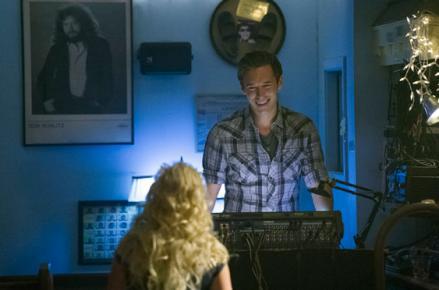Talking to David Plotz about Wednesday’s episode of Nashville got me ponderin’ a mess of things, like why the show is so unsentimental about what music can and can’t do and whether Scarlett is a secret narcissist. After the chat, though, commenters fixated on a very specific Plotzian claim, which I feel obligated to address here before the ghosts of Betty Friedan and Mae West swoop down to revoke my feminism card.
Basically, Plotz believes that the male characters on Nashville are far fresher and dewier and prettier than the female characters. With the exception of Scarlett, he says, the women are either intimidatingly tough (Juliette) or, you know, old (Rayna, sister Tandy, Peggy, hot reporter, cougar agent). Meanwhile, the guys read as young, soft, and uncomplicatedly attractive, from stubbly Avery to baby-faced Gunnar to Teddy to Liam to Sean. “It seems like the idea is to make a show that women in their 40s will like, with women who are attainably beautiful and age appropriate, and then male arm candy,” Plotz concludes.
To which I said at first (with all the respect I could muster, given that David is my boss), pshaw. Because, obviously, Rayna and Juliette are gorgeous, light years away from “attainably” so, with their toned bodies and luminous skin and hair tousled by invisible winds of pure sex appeal. If Scarlett is an exception, she is a huge one, and Gunnar’s one-time girlfriend Hailey has dark tresses, a lovely complexion (probably all that yogurt), and flashing, bottomless eyes. Furthermore, though the male side of Nashville abounds with older dad-types (Glenn, Coleman), gross, dried-up rockers (the Revel Kings), unremarkable-looking producers (Randy, Marshall Evans), and humans who resemble bulldogs (Lamar), I cannot name any equivalently average-looking women. If pressed, I would have guessed that Nashville expected slightly more, in the looks department, from the women than from the guys—and that in that respect it joined the ranks of probably every network television show, ever.
But now I’m wondering whether there might be something to Plotz’s thesis. Not the part about the women being “attainably attractive” (though I can understand how Rayna comes across as more hardworking and decent than sexy, even as Deacon, her counterpart, is pure smolder), but the part about the guys being unusually objectified. Nashville does boast an alarming number of extremely good-looking male characters. They fit very specific archetypes of hotness: indie rock hottie (Liam), young ambitious hottie (Avery), quiet soulful hottie (Gunnar), seasoned/wounded hottie (Deacon), jailbird hottie (Jason), choirboy/quarterback hottie (Sean).
Perhaps the show’s aesthetic of young, pretty men reveals its debt to the soap opera genre. (Aren’t daytime soaps always producing gorgeous pool boys and surgeons from their sleeves, Houdini-like, to titillate female viewers? Prototype: Josh Duhamel.) Television in general could be growing more equitable, or more interested in appealing to 100 percent of its audience, rather than 50 percent. Or maybe the explanation lies with country music: the brawny physicality of its sound, the adoration of the cowboy, something else in the genre’s mythology that makes us think of guys as sex objects.
Or maybe, just maybe, it has to do with Callie Khouri herself. Don’t forget that in Thelma & Louise, she wrote two attainably beautiful, early-middle-aged women, and one cartoonishly sexy archetypal bad boy – played by unknown, fresh-faced Brad Pitt. Remember his abs in that movie? Yes, you do.
Whatever the reason, I applaud Nashville’s commitment to XY eye candy. There’s nothing wrong with using your TV as a portal to fantasies of flawless male beauty, especially if doing so makes you contemplate a privilege straight guys have enjoyed for time immemorial.
Or as a Nashvillian might say, yee-haw.
